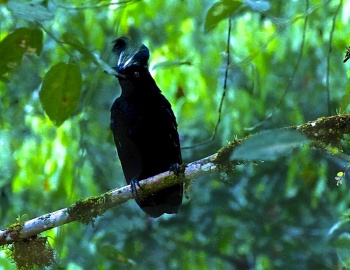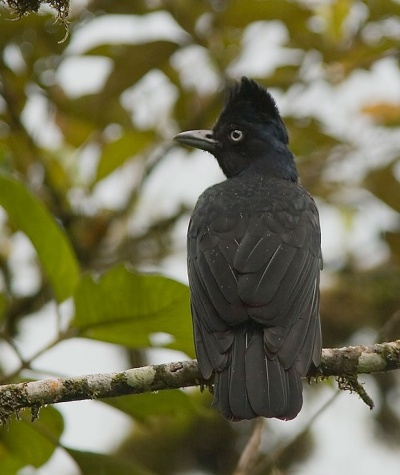(User template) |
m (→External Links: {{GS-checked}} <br /> <br />) |
||
| (3 intermediate revisions by one other user not shown) | |||
| Line 1: | Line 1: | ||
| − | [[Image: | + | [[Image:Amazonian-Umbrellabird Peru06 0002.jpg|thumb|400px|right|Male<br />Photo by {{user|Leif+G|Leif G}}<br /> Yanachaga-Chemillen National Park, [[Peru]], October 2006]] |
;[[:Category:Cephalopterus|Cephalopterus]] ornatus | ;[[:Category:Cephalopterus|Cephalopterus]] ornatus | ||
==Identification== | ==Identification== | ||
| + | Male 48–51 cm; female 41–43 cm<br > | ||
Large, all-black cotinga with heavy bill, pale eye, and crest. | Large, all-black cotinga with heavy bill, pale eye, and crest. | ||
==Distribution== | ==Distribution== | ||
| − | [[ | + | [[South America]]: found from southern [[Venezuela]] to [[Guyana]], northern [[Bolivia]] and Amazonian [[Brazil]] |
==Taxonomy== | ==Taxonomy== | ||
| − | [[ | + | This is a [[Dictionary_M-S#M|monotypic]] species<sup>[[#References|[1]]]</sup>. |
| − | |||
| − | |||
==Habitat== | ==Habitat== | ||
| − | In [[Peru]], uncommon in humid montane forest on east slope of Andes, 600-1650m. | + | [[Image:Amazonian UmbrellabirdSJ.jpg|thumb|350px|right|Juvenile<br />Photo by {{user|Stanley+Jones|Stanley Jones}}<br />Podocarpus National Park, Zamora-Chinchipe Province, [[Ecuador]], November 2014]] |
| + | In [[Peru]], uncommon in humid montane forest on east slope of Andes, 600-1650m. <br /> | ||
| + | Also locally in Amazonia, where apparently confined to floodplains of large rivers and forested river islands. | ||
==Behaviour== | ==Behaviour== | ||
| − | The diet includes berries | + | ====Diet==== |
| − | + | The diet includes berries, palm fruits nuts and large insects. They will also eat lizards occasionally. | |
| − | + | ====Breeding==== | |
| − | + | They construct a platform nest from loose twigs. The single egg is beige with brownish spotting and stippling. | |
| − | + | ==Gallery== | |
| + | Click on photo for larger image | ||
| + | <gallery> | ||
| + | Image:Amazonian_Umbrellabird_imm.jpg|Immature male<br /> Photo by {{user|pbono|Peter R. Bono}}<br />along Manu Road, below [[Cock-of-the-Rock Lodge]] (1050m), [[Peru]], August 2008 | ||
| + | <!--Editors: Image retained as it is not in the Gallery--> | ||
| + | </gallery> | ||
| + | ==References== | ||
| + | #{{Ref-Clements6thAug14}}#Handbook of the Birds of the World Alive (retrieved April 2015) | ||
| + | #Answers.com | ||
| + | {{ref}} | ||
==External Links== | ==External Links== | ||
{{GSearch|Cephalopterus+ornatus}} | {{GSearch|Cephalopterus+ornatus}} | ||
| + | |||
[[Category:Birds]][[Category:Cephalopterus]] | [[Category:Birds]][[Category:Cephalopterus]] | ||
| + | {{GS-checked}} | ||
| + | <br /> | ||
| + | <br /> | ||
Latest revision as of 07:25, 10 January 2022
- Cephalopterus ornatus
Identification
Male 48–51 cm; female 41–43 cm
Large, all-black cotinga with heavy bill, pale eye, and crest.
Distribution
South America: found from southern Venezuela to Guyana, northern Bolivia and Amazonian Brazil
Taxonomy
This is a monotypic species[1].
Habitat

Photo by Stanley Jones
Podocarpus National Park, Zamora-Chinchipe Province, Ecuador, November 2014
In Peru, uncommon in humid montane forest on east slope of Andes, 600-1650m.
Also locally in Amazonia, where apparently confined to floodplains of large rivers and forested river islands.
Behaviour
Diet
The diet includes berries, palm fruits nuts and large insects. They will also eat lizards occasionally.
Breeding
They construct a platform nest from loose twigs. The single egg is beige with brownish spotting and stippling.
Gallery
Click on photo for larger image
Immature male
Photo by Peter R. Bono
along Manu Road, below Cock-of-the-Rock Lodge (1050m), Peru, August 2008
References
- Clements, J. F., T. S. Schulenberg, M. J. Iliff, D. Roberson, T. A. Fredericks, B. L. Sullivan, and C. L. Wood. 2014. The eBird/Clements checklist of birds of the world: Version 6.9., with updates to August 2014. Downloaded from http://www.birds.cornell.edu/clementschecklist/download/
- Handbook of the Birds of the World Alive (retrieved April 2015)
- Answers.com
Recommended Citation
- BirdForum Opus contributors. (2024) Amazonian Umbrellabird. In: BirdForum, the forum for wild birds and birding. Retrieved 10 May 2024 from https://www.birdforum.net/opus/Amazonian_Umbrellabird
External Links
GSearch checked for 2020 platform.





